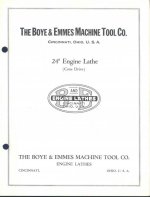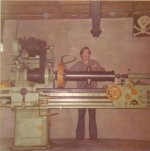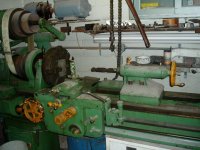Jim:
Thanks for the "plug". I did check the ABB-Dodge website. The coupling on the OP's lathe drive is still in production as the "polyflex" or something like it. By going to a shop specializing in power transmission, they should be able to match up the correct coupling element.
What I did do for replacing some ancient Thermoid dampener (or flex) type couplings was to "reverse engineer" the coupling elements which were no longer available. These were a rubber/canvas "sandwich" material. I obtained some heavy rock-quarry conveyor belt material to make the new discs from. I made an "as built" drawing of the coupling bolt circle and overall dimensions. I then had new discs cut from the conveyor belting material by a shop using CNC Waterjet cutting. Since the original discs were a good bit thicker, we assembled two discs with the coupling bushings installed in them, and then glued the two together using Devcon urethane.
The result is good coupling discs which are in service for a few seasons now.
Rather than "reinvent the wheel" if it is not necessary, I'd suggest the OP find a Dodge distributor and ask about ordering new coupling elements. The elements are made of a variety of elastomers for different service applications. Why the one on the drive of the OP's lathe failed is a good question. Most likely, it got brittle with age and locked itself onto the coupling hub drive pins. When the motor was dismounted, the coupling element could not make up its mind whether to stick with the motor or the input shaft of the gear reducer, so parted company.
From the looks of things, the drive on the OP's lathe is built around a single-speed gear reducer. With a single pulley on the gear reducer output shaft, the lathe only has two operating speeds: direct and back geared. It is a heavy duty lathe of fairly large capacity, so living with these low spindle speeds for large diameter work was likely not an issue for the previous owner. With 200 bucks invested in this lathe, the cost of a replacement coupling element might well be nearly 50% of the purchase price. Investing in a VFD drive to give variable spindle speeds would likely run into more money than the purchase price of this old workhorse. Interesting to contemplate, though.
![IMG_20200401_164724721[1].jpg IMG_20200401_164724721[1].jpg](https://www.practicalmachinist.com/forum/data/attachments/238/238780-d22fc6f6b4b8f7fc4e053b6dc1932902.jpg)
![IMG_20200401_164706158[1].jpg IMG_20200401_164706158[1].jpg](https://www.practicalmachinist.com/forum/data/attachments/238/238781-9968df7b686900140213dd510a0f9703.jpg)
![IMG_20200401_165000774[1].jpg IMG_20200401_165000774[1].jpg](https://www.practicalmachinist.com/forum/data/attachments/238/238782-4199143344e2c6c83ba1fe03d1a5080b.jpg)
![IMG_20200401_164724721[1].jpg IMG_20200401_164724721[1].jpg](https://www.practicalmachinist.com/forum/data/attachments/238/238780-d22fc6f6b4b8f7fc4e053b6dc1932902.jpg)
![IMG_20200401_164706158[1].jpg IMG_20200401_164706158[1].jpg](https://www.practicalmachinist.com/forum/data/attachments/238/238781-9968df7b686900140213dd510a0f9703.jpg)
![IMG_20200401_165000774[1].jpg IMG_20200401_165000774[1].jpg](https://www.practicalmachinist.com/forum/data/attachments/238/238782-4199143344e2c6c83ba1fe03d1a5080b.jpg)












